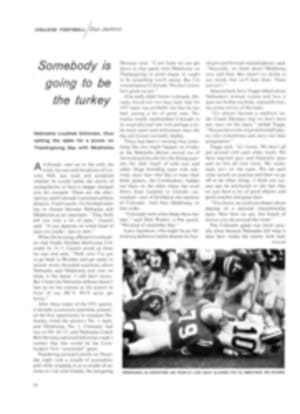
Winning Wasn't Anything
In the football seasons of 1939-40-41 a kind of Messiah of the also-rans arose among college coaches in America. He was Stewart Ferguson, a friendly professor with a Ph.D. and a unique football philosophy that hinged on failure of a sort. He agreed to coach the Arkansas A&M football team only after it was spelled out in his three-year contract that he didn't have to win a single game, and he seemed happiest when his Boll Weevils were losing—as long as they had fun doing it.
Some coaches considered him an eccentric, or worse. Among other things that Ferguson insisted upon was that his athletes—and he attracted some excellent ones—receive no financial help. And he encouraged his teams to do some strange things, like punt backward after they had driven down to the opposition goal line.
"Above all," he once declared, "football must be fun. We'll trade a laugh for a touchdown any day."
What private vision drove Ferguson and his football squads may never be known, but the coach did admit that the Boll Weevils were the instruments of his aim to "ridicule and satirize high-pressure collegiate football." He wanted "to give the game back to the boys."
The "boys" on Ferguson's first Weevil squad were scarcely that. They included a 38-year-old Methodist preacher, the town barber in Monticello, Ark. and a former cheerleader whom Ferguson transformed into a passer. There were also a number of really gifted athletes, several of them acrobats and gymnasts, and two who had won collegiate wrestling titles. They were doubtless good enough to have won most of the 33 games they played through this era, but Ferguson's men were never ones to let victory get in the way of success. And so, from 1939 to 1941, their record was three wins, 30 losses and no ties—a triumph of imagination over incentive.
"We had to work hard to lose some of those games," recalled John Scritchfield of Austin, Texas, who played halfback, guard, center and end on all three of Ferguson's squads. They also had to go a long way to lose. Ferguson loved to travel, and he planned the Weevil schedule so that only five games were played at home while he coached at A&M. For the rest, the Weevils journeyed as far as California, Pennsylvania and South Dakota. In light of their record, this arrangement might seem more self-protection than desire, but Ferguson just thought travel would broaden his men. As for the games played once the Weevils got there, things occasionally turned downright absurd. For one thing, the team was frightfully casual about scoring touchdowns. "Just when we were on the lip of the enemy goal and about to score," Scritchfield said, "we'd go into our London Bridge Is Falling Down formation—that is, the whole team would just fall flat—or Red England or one of our other punters would whirl and kick the ball back downfield."
Scritchfield, who later was the first-string quarterback for Georgia Pre-Flight, a service team that remained unbeaten and had four All-Americas on its roster, said Ferguson didn't actually discourage touchdowns. "Sometimes he'd let us score early just to unnerve the opposition," he recalled. One maneuver that Ferguson instituted probably did more than unnerve the opposition. J. P. Leveritt, a halfback, perfected a play in which he would walk on his hands for a touchdown with the football clutched between his legs. Once he hand-walked in from the 15.
"It certainly upset the other team to give up six points to a ballcarrier walking on his hands," said Scritchfield. "The other side would figure at that point we were going to give them a bad whipping. After one of those walk-in touchdowns we might drive right down to the goal line again, but then we'd revert to our losing style. In one game against a Pennsylvania college, we scored that way, then drove to their five-yard line on the next series. But instead of running it over, we huddled and made up a play involving 19 successive laterals that carried us back to our own 10."
Ferguson's ambition to lose all his games eluded him until his final season at A&M. He failed in 1939 when his team played one of its two home games of the year and beat Northwest Mississippi College 26-6. In the 1940 campaign the Weevils nearly found themselves humiliated, beating both Northwest Mississippi and the South Dakota School of Mines. But his 1941 team, which he called his masterpiece, managed to lose all 12 of its games. To achieve this inverted perfection he had to make adjustments in the schedule, scratching off the South Dakota and Mississippi outfits as being simply too inept.
Some sportswriters and coaches who didn't understand Ferguson's motivations pictured him as either crazy or a man who hated football. Neither assessment was correct. If anything, he loved football too much to willingly accept the excesses of overemphasis. He had been a successful college player, achieving Little All-America honors as an end at Dakota Wesleyan, and for five years prior to taking on the Arkansas A&M job he had been the winningest coach in the history of his alma mater. There he was regarded as an authority on scoring from within the 10-yard line, and he even wrote an article on the subject for the Athletic Journal.
From Dakota Wesleyan he moved on to A&M, where in addition to his duties as dean of men, he was coach and athletic director and an instructor in psychology, biology and medieval history. Prior to his arrival, the school had been subsidizing football for years, yet had lost most of its games and much money. They were about to abandon the sport when Ferguson proposed his "simon-pure" program. All he wanted was a strict "no-win" policy from administration and alumni and great latitude in preparing road schedules.
The majority of the squad he assembled were phys-ed majors, but Ferguson—a Rhodes Scholar nominee—had other A&M professors block out courses of study for the footballers during their long road trips. The coach would hold classes daily and would supervise study periods. He often got permission for the Weevils to attend classes at colleges along the way. Southern Cal, Notre Dame, Yale and Hofstra were just a few of the schools where his players occasionally audited.
His music majors managed to attend operas and concerts in large cities. His agriculture majors took soil samples all over the country. Art and history majors hit big-time galleries and historical sites. The Boll Weevils of 1939-41 were a kind of road-company lyceum. And during those three seasons, the football players made better grades on the average than their stay-at-home classmates.
Meanwhile, they were endearing themselves to football fans all over the country. Bored with the reverence paid to winning teams and winning coaches, many people found this troupe of eccentrics a refreshing relief. The New York Times reported: "If other coaches would follow Professor Ferguson's coaching philosophy, football might be returned to the sanity of its early days." The Los Angeles Times crusaded unsuccessfully to have A&M play another group of "pure amateurs" in a preliminary game before the 1940 Rose Bowl contest.
Their flattering notices in the press (one journal dubbed them the "Marx Brothers of football") gave the Arkansas squad a spirited box office. Despite the expenses of bumping around the nation in a bus, the Weevils showed a profit in each of Ferguson's three seasons.
Not all the A&M shenanigans occurred on field. A 6'7" pass-catching gymnast named Lawrence (The Stork) Lavender was occasionally dolled up before games in a bobtailed dress coat, starched white shirtfront and white tic over his game jersey, and wearing gloves, a silk top hat and, sometimes, a monocle. A "valet" helped him dress.
The A&M colors were green and white, yet the squad took along road jerseys of many colors, and Ferguson let the players wear any combination they wished. Sometimes the team changed colors at halftime, even emerging in jerseys of the same color as the other team.
As long as his players were behaving themselves, Ferguson exerted no real control over them during a game. Each was allowed to take any position he wished, and substitutions were at the whim of the players themselves. Subs rode a bicycle from bench to field, and the replaced player rode it back. Players were free to leave the bench and join friends in the stands. One of the better ballcarriers, Bix Stillwell, was also a spectacular drummer. He would take himself out of games and sit in with the opposing team's band at odd moments, sometimes—according to John Scritchfield—getting long ovations from the fans for his drum solos.
"I enjoyed the games each of those seasons because I could sit on the sidelines and wonder what my players were going to do next," Ferguson reminisced afterward. So, no doubt, did the Weevils' fans and opposition.
J. S. Shapiro, who sometimes played halfback, rarely wore shoes in a game, even in northern snow. An extra-point attempt by either team in a Weevil game was apt to be traumatic. On tries by the opponent, all the Weevils frequently collapsed to the turf on the snap from center, causing the startled kicker to boot the ball wide of the uprights. If A&M scored, the point-after could be equally bizarre. Some of the Weevil players would line up with their backsides to the other team. Then the placekicker would do something awkward, like missing the football and booting the ball holder, usually an acrobat, who would then do a series of backflips over the goal line. Bear Bryant would have cried.
Ferguson could be a tough disciplinarian. The Weevils were drilled long hours on fundamentals and spent still more time at calisthenics and gymnastics, so they were always in unusually good condition. Not one serious injury hit the Weevils in his three seasons. Ferguson squads always behaved like gentlemen. At hotels and motels where they stayed, managers praised their behavior, in contrast with other visiting teams'.
Ferguson went into the service in 1942 and never returned to Arkansas A&M. When he died in 1955 he had been for 10 years the football coach at Deadwood (S. Dak.) High, and his obituary said: "This 55-year-old coach won fame for himself at Arkansas A&M by practicing the theory that a football team doesn't have to win games to provide entertainment for the fans and fun for the players. He used much the same coaching tactics at Deadwood High."
Once when his 1941 Boll Weevils were to play a game with Bradley University in Peoria, Ill. (the Weevils lost 67-0), Ferguson told a group of sportswriters: "You fellows laugh at my boys when they're losing on Saturdays. Yet for the rest of the week they're learning more, absorbing more culture and social graces than any other football squad in this nation."

